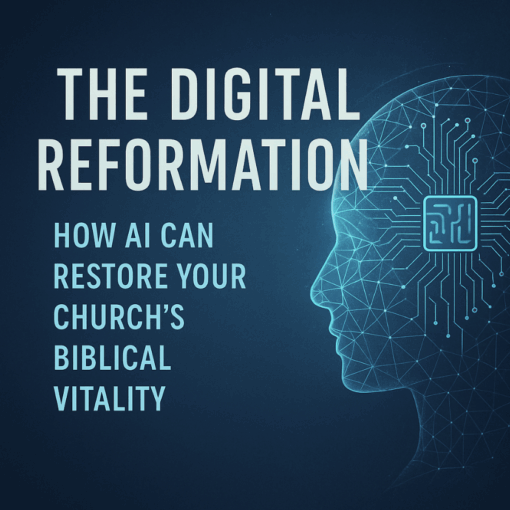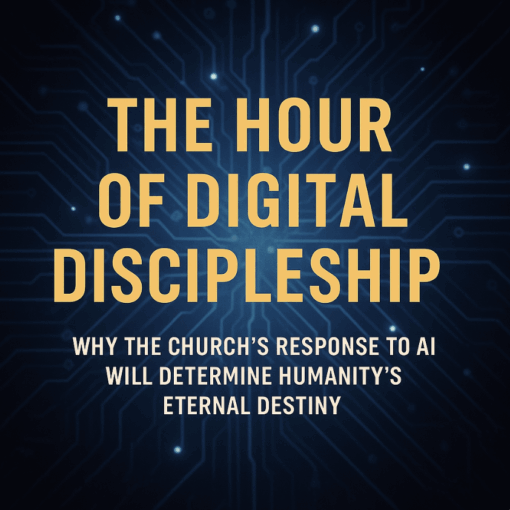
Quick Summary
- The DAVID Protocol transforms Christian leaders from AI observers to AI stewards
- Each step—Discernment, Accountability, Vision, Integrity, Deployment—builds upon biblical wisdom
- David’s progression from shepherd to king mirrors our journey from simple tools to complex AI systems
- This framework ensures technology serves Kingdom multiplication, not human ambition
🔥 The Shepherd Boy’s Weapon
When David faced Goliath, he rejected Saul’s armor for five smooth stones and a sling—tools he had mastered through faithful stewardship of smaller things. Today, as artificial intelligence reshapes our world with the force of a thousand Goliaths, Christian leaders face a similar choice: Will we flee in fear, adopt the world’s approaches, or step forward with divinely-guided discernment?
The DAVID Protocol is not another tech framework dressed in Christian language. It is a battlefield-tested methodology for wielding the most powerful tools of our generation—artificial intelligence systems—with the same Spirit-led wisdom that guided a shepherd boy to victory.
🎯 From Confusion to Clarity: The Protocol Revealed
Like David’s stones, each element of this protocol has been crafted through years of testing in the fires of real ministry, business challenges, and technological complexity. The DAVID Protocol stands for:
D – Discernment
A – Accountability
V – Vision
I – Integrity
D – Deployment
This is not theoretical theology. This is practical wisdom for leaders who refuse to let artificial intelligence advance without Kingdom influence.
Step 1: Discernment – “Test the Spirits”
“Beloved, do not believe every spirit, but test the spirits to see whether they are from God.” (1 John 4:1)
Before David chose his stones, he discerned the true nature of his enemy. Before we deploy any AI system, we must discern its spiritual and practical implications.
The Discernment Framework:
Spiritual Assessment:
- Does this technology amplify human creativity or replace human dignity?
- Will it draw people closer to truth or deeper into deception?
- Does it serve multiplication of Kingdom values or merely efficiency?
Practical Assessment:
- What data does it require, and how is it used?
- Who controls the algorithm, and what values do they embed?
- Can we understand its decision-making process?
Biblical Filter: Apply the Philippians 4:8 test: Is it true, noble, right, pure, lovely, admirable, excellent, or praiseworthy? If an AI system consistently produces outputs that fail this test, no amount of efficiency justifies its use.
Real-World Application: Before implementing a customer service chatbot, ask: “Does this tool serve our clients better, or does it merely reduce our costs while diminishing human connection?” The answer determines whether you proceed or pursue alternatives.
Step 2: Accountability – “In a Multitude of Counselors”
“Plans fail for lack of counsel, but with many advisers they succeed.” (Proverbs 15:22)
David surrounded himself with mighty men—warriors who could challenge his decisions and cover his blind spots. AI stewardship demands the same collective wisdom.
The Accountability Structure:
Technical Accountability: Engage someone who understands the actual capabilities and limitations of the AI systems you’re considering. Not all advice is equal—seek counsel from those who’ve actually implemented similar technologies.
Spiritual Accountability: Include mature believers who can discern spiritual implications you might miss. They ask questions like: “How does this align with our calling to make disciples?” and “What unintended consequences might this create?”
Ethical Accountability: Involve stakeholders who will be affected by your AI implementation. Their perspective prevents the common mistake of optimizing for internal efficiency while creating external friction.
Practical Framework: Form an “AI Advisory Circle” of 3-5 people representing these different perspectives. Meet quarterly to review all AI implementations, ensuring decisions serve Kingdom purposes rather than mere convenience.
Step 3: Vision – “Where There Is No Vision”
“Where there is no vision, the people perish.” (Proverbs 29:18 KJV)
David didn’t fight Goliath to win a battle—he fought to demonstrate God’s power to two watching armies. Your AI implementation must serve a vision larger than operational improvement.
The Vision Alignment Process:
Kingdom Purpose Definition: Every AI tool must answer: “How does this advance the multiplication mandate of 2 Timothy 2:2?” If it doesn’t help you teach others who can teach others, it may be a distraction from your core calling.
Impact Amplification: Ask: “Does this AI system multiply our ability to serve people, or does it substitute technology for human relationship?” The goal is amplification of ministry, not replacement of ministers.
Legacy Perspective: Consider the multi-generational impact. Will this AI implementation create sustainable Kingdom benefit, or does it create dependencies that weaken future generations’ capacity for faithful stewardship?
Practical Implementation: Write a one-page “AI Vision Statement” that clearly articulates how each technology serves your larger Kingdom mission. Review this annually, ensuring your tools remain servants rather than masters of your vision.
Step 4: Integrity – “Let Your Yes Be Yes”
“Let your ‘Yes’ be ‘Yes,’ and your ‘No,’ ‘No.'” (Matthew 5:37)
David’s integrity was established in the wilderness, tending sheep with the same faithfulness he would later bring to ruling Israel. AI integrity must be proven in small implementations before scaling to larger systems.
The Integrity Checklist:
Transparency Standards: Can you explain to any stakeholder how your AI systems work and why you chose them? Hidden algorithms serving God’s people violate the principle of transparency that should characterize Kingdom leadership.
Data Stewardship: Treat all data as sacred trust. Personal information shared with your ministry or business is not commodity for optimization—it’s trust to be stewarded with the same care you would want for your own family’s information.
Bias Recognition: All AI systems embed their creators’ biases. Actively identify and address these biases, especially when they conflict with biblical values of human dignity, justice, and mercy.
Promise Alignment: Ensure your AI capabilities match your public promises. Overstating AI abilities to gain credibility or funding violates integrity and ultimately damages trust.
Implementation Standard: Create an “AI Integrity Audit” checklist that every system must pass before deployment. Include specific criteria for transparency, data protection, bias mitigation, and honest capability representation.
Step 5: Deployment – “Faithful in Little, Ruler Over Much”
“Whoever is faithful in very little is also faithful in much.” (Luke 16:10)
David proved faithful with sheep before receiving armies. Your AI deployment should follow the same pattern—faithful stewardship of simple tools before advancing to complex systems.
The Strategic Deployment Path:
Pilot Phase (90 Days): Deploy AI in low-risk environments with clear success metrics. Test not just technical function but spiritual and relational impact. How does this technology affect the culture of your team and the experience of those you serve?
Scale Phase (6-12 Months): Expand successful pilots while maintaining hands-on oversight. This phase reveals whether your AI systems truly serve multiplication or merely create impressive demonstrations.
Integration Phase (12+ Months): Integrate proven AI tools into your core operations, ensuring they enhance rather than replace human relationships central to Kingdom work.
Multiplication Phase (Ongoing): Train others to implement similar AI strategies, fulfilling the 2 Timothy 2:2 mandate. Your AI stewardship should become a model others can replicate.
Deployment Discipline: Resist the temptation to deploy impressive AI capabilities that don’t serve your core mission. The goal is faithful stewardship, not technological sophistication.
⚔️ The Protocol in Action: A Modern David’s Story
Marcus, a pastor and business owner, faced pressure to implement AI chatbots across his consulting firm and church communications. Instead of rushing toward efficiency, he applied the DAVID Protocol:
Discernment: He discovered that while chatbots could handle basic inquiries, they couldn’t provide the pastoral care that people actually needed during initial contact.
Accountability: His advisory circle helped him realize that his motivation was partially ego-driven—wanting to appear innovative rather than serving people better.
Vision: He refined his approach to focus AI on research and content preparation, freeing him for more face-to-face ministry rather than replacing human interaction.
Integrity: He was transparent about AI use in content creation and ensured all AI-generated material underwent human review for theological accuracy.
Deployment: He started with internal research tools, proved their value over six months, then gradually introduced AI-assisted content creation while maintaining personal oversight.
The result? Marcus’s firm grew 40% while his pastoral ministry deepened. AI became a faithful servant to his calling rather than a substitute for it.
🚀 Your DAVID Protocol Journey
The artificial intelligence revolution will not wait for the Church to catch up. Like David facing Goliath, we can either trust in human armor that doesn’t fit, or we can step forward with tools surrendered to divine purpose.
The DAVID Protocol is your sling. Artificial intelligence is your stone. The Kingdom of God is your target.
Your Next Step: Choose one AI tool you’re considering or currently using. Apply the first step—Discernment—using the framework above. Don’t proceed to implementation until you can clearly articulate how this technology serves Kingdom multiplication rather than mere convenience.
Want the Complete DAVID Protocol Toolkit?
If you’re serious about becoming an AI steward rather than an AI consumer, join the 2T22 Multiply Bootcamp where we dive deeper into each protocol step with practical templates, real-world case studies, and a community of leaders applying these principles.
“The boy David said to the Philistine, ‘You come against me with sword and spear and javelin, but I come against you in the name of the Lord Almighty.'” (1 Samuel 17:45)
In the age of artificial intelligence, may the same be said of us.
From Protocol to Practice: Your Kingdom AI Journey
Whether you’re a Kingdom entrepreneur exploring AI integration, a pastor considering digital discipleship tools, or a business leader seeking biblical wisdom for emerging technologies, you’re not walking this path alone. The DAVID Protocol transforms uncertainty into confident stewardship, fear into faithful action, and technological chaos into Kingdom opportunity. From AI ethics frameworks to digital ministry strategies, from business automation to disciple multiplication systems, we’re building a community where ancient wisdom meets cutting-edge innovation. Join leaders who refuse to let artificial intelligence advance without Kingdom influence, and discover how biblical principles can guide every algorithm, every implementation, and every strategic decision in the digital age.



